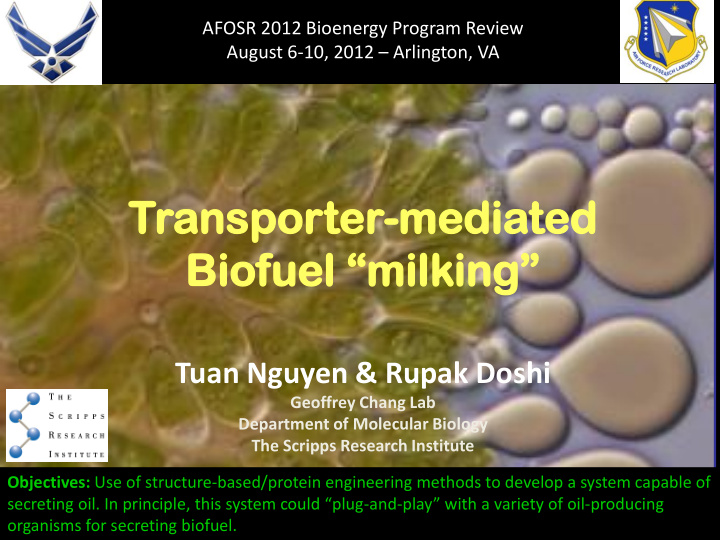



AFOSR 2012 Bioenergy Program Review August 6-10, 2012 – Arlington, VA Transpor ansporter ter-media mediated ted Biofuel “milking” Tuan Nguyen & Rupak Doshi Geoffrey Chang Lab Department of Molecular Biology The Scripps Research Institute Objectives: Use of structure-based/protein engineering methods to develop a system capable of secreting oil. In principle, this system could “plug -and- play” with a variety of oil -producing organisms for secreting biofuel.
Outline 1. Biofuel milking: why and how? 2. Membrane proteins and ABC-transporters 3. Experimental strategy Tuan Nguyen 4. Selection of transporter candidates 5. Selection of substrate candidates 6. Construction of E. coli strains for transport assay 7. In vitro transport assay 8. In vivo transport assay (intact cell & spheroplast) Rupak Doshi 9. Future directions - Certain ABC transporters can export biofuel substrates - Secretion could lead to higher yields of biofuels
Current Biofuel Platforms for Commercial Production “Farming” (sunlight harvesting using algae) “Fermentation” (mixotrophic algae, yeast…) Sapphire Energy, PetroAlgae, Synthetic Solarzyme, Amyris Biotechnologies, LS9, Genomics… Coskata… Harvesting & extraction of biofuels is energy-intensive! From our pharmacology perspective: How do cells transport hydrophobic oil-like molecules across the lipid bilayer? Develop a “plug -and- play” secretion system that is energy-efficient and sustainable.
Andrew Ward Jodie Yu MsbA Christopher Reyes (ABC) Christopher Roth Qinghai Zhang (TSRI) Andrew Ward Yue Weng Rupali Aggarwal Srinivas Chittaboina P-glycoprotein Alexandra Caya (ABC) Ina Urbatsch (TTUHSC) Steve Aller Rupeng Zhuo Jodie Yu Patrina Harrel Yenphuong Trinh Yong Yin Xiao He EmrD That Nguyen (MFS) Paul Szewczyk Xiao He Miriah Hevin NorM Paul Szewczyk Wen-Xu Hong (MATE) Andrey Karyakin Qinghai Zhang Yen-Ju Chen Samantha Lieu EmrE Kruwlich et al., 2005. 3, 566-572 Owen Pornillos Andy Chen (SMR) Alex Ma
The ABC-transporter family - structure and function - Structure Hydrophobic substrate binding model
The ABC-transporter family - diversity of substrates - Diversity of molecules recognized by Pgp (ABCB)
The ABC-transporter family - classification - Family Characteristics Function Very large in size Transport cholesterol and lipids. ABCA Contain both full & half transporters Transport lipids and diverse drug ABCB substrates Full transporters Ion transport, toxin secretion ABCC Half transporters Only in peroxisomes ABCD Contains only ABC domain and no Not actual transpoters ABCE/F transmembrane domain Half transporters in reverse Transport lipids, drugs, bile, cholesterol ABCG orientation and other steroids
Transporter- mediated biofuel “milking” Screen and re-engineer potential transporters for binding and Identify biofuel molecules where the metabolic pathway transport, focusing mostly on ABCB and ABCG family and hosts are well-established. “Pumps” (ABC transporters) “Substrates” Terpenoids (isoprenoids): MVP & MEP pathways ABCB family: - Monoterpenes (C10, limonene, camphor, carvone, eucalyptol) 1. Lipid flippase MsbA (9 bacterial orthologs) 2. Lipid flippase MDR3/ABCB3) 3. “Drug” transporters (Pgp/MDR1/ABCB1) 4. B. braunii transcriptome ABCB ORFs - ORF #7809 - Triterpenes (C30+, squalene, botryococcenes) - ORF #33468 - ORF #26423 - ORF #24910 - Tetraterpenes (C40, carotene, lycopenes) ABCG family: Wax, paraffin: very long chain alkanes (C n H 2n+2 ) 1. Cholesterol excretion (ABCG5/8) 2. Plant wax transporters (wbc11/12) 3. B. braunii transcriptome ABCG ORFs - ORF #24393 Triacylglyceride (TAG, fat): - ORF #19521 - ORF #7846 - ORF #33471
Screening of transporter candidates Transporter Descriptions Progress Plant Wax Transporter - Genes codon-optimized & synthesized - CER5 and WBC11 (WBC11/12) form - Expressed & screened in Pichia a heterodimer to transport long chain - Found no clone with good expression hydrocarbons (Samuels et al., Annu. Rev. Plant for WBC11/12 Biol, 2008). - EIBI1 full-size ABCG wax transporter - Eibi1 screening is underway (Chen et al, PNAS 2011) . - ORFs of ABCB & ABCG homologs B. braunii transcriptome ABCBs identified from B. braunii transcriptome and ABCGs - Genes codon-optimized & synthesized ABCB: 7809, 33468, 26423, 24910 - Expressed & screened in Pichia - Large-scale expression and purification ABCG: 24393, 19521, 7846, 33471 testing is underway Bacterial & mamalian ABCBs - Obtain 19 MsbA homolog constructs in MsbA and its homologs pET19b - ATPase assay against a variety of PGP terpenoids - In vitro and in vivo transport assay Rupak’s talk
Screening of substrate candidates Substrate Descriptions Progress Liquid fuels (Botryococcenes…) - SSL1 and SSL3 cloned in E. coli Gene SSL1/3 responsible for pET19b (IPTG induction) and pBAD28 (arabinose induction). botryococcenes synthesis - In vitro synthesis of Botryococcenes identified (Niehaus et al.,PNAS, 2011). using FPP and SSL1/3 is underway. Carotenoids - Obtain 8 constructs for carotenoids Lycopene, carotene, canthaxanthin, expression in E. coli (Dr. Cunningham, Univ. of Maryland). phytoene, zeaxanthin, etc… - Create BL21 E. coli strains expressing both carotenoids and MsbA homologs - In vitro and in vivo transport assay Rupak’s talk
MVA, MEP, botryococcenes & carotenoid pathways GPP (C10) FPP synthase FPP (C15) BSS SSL1 SSL2 Squalene (C30) PSPP (C30) SSL3 Botryococcenes (C30) SSL1 + SSL2 = squalene SSL1 + SSL3 = botryococcenes (Niehaus et al.,PNAS, 2011).
Carotenoid-expressing E. coli strains Constructs Phenotype 1. GGPP ipi colorless ipi crtE colorless 2. Phytoene ipi ipi crtE crtB red 3. Lycopene ipi ipi crtE crtB crtI yellow 4. Delta-carotene crtE crtB crtI lcyE1 yellow 5. Epsilon-carotene ipi ipi crtE crtB crtI lcyE2 yellow 6. Beta carotene ipi ipi crtE crtB crtI crtY pink 7. Canthaxanthin ipi ipi crtE crtB crtI crtY bkt 8. Zeaxanthin ipi ipi crtE crtB crtI crtY crtZ yellow (Adapted from Cunningham & Gantt, 2007)
E. coli strains for transport assays Features Carotenoid-expressing constructs Transporter-expressing constructs Backbone pAC184 pET19B Antibiotic resistance Cm R Amp R Origin of replication p15A pBR322 Promoter/Induction Constitutive / None T7 / IPTG Pair-wise double transformation to E. coli BL21 strain IPTG induction Transport assays
Recommend
More recommend